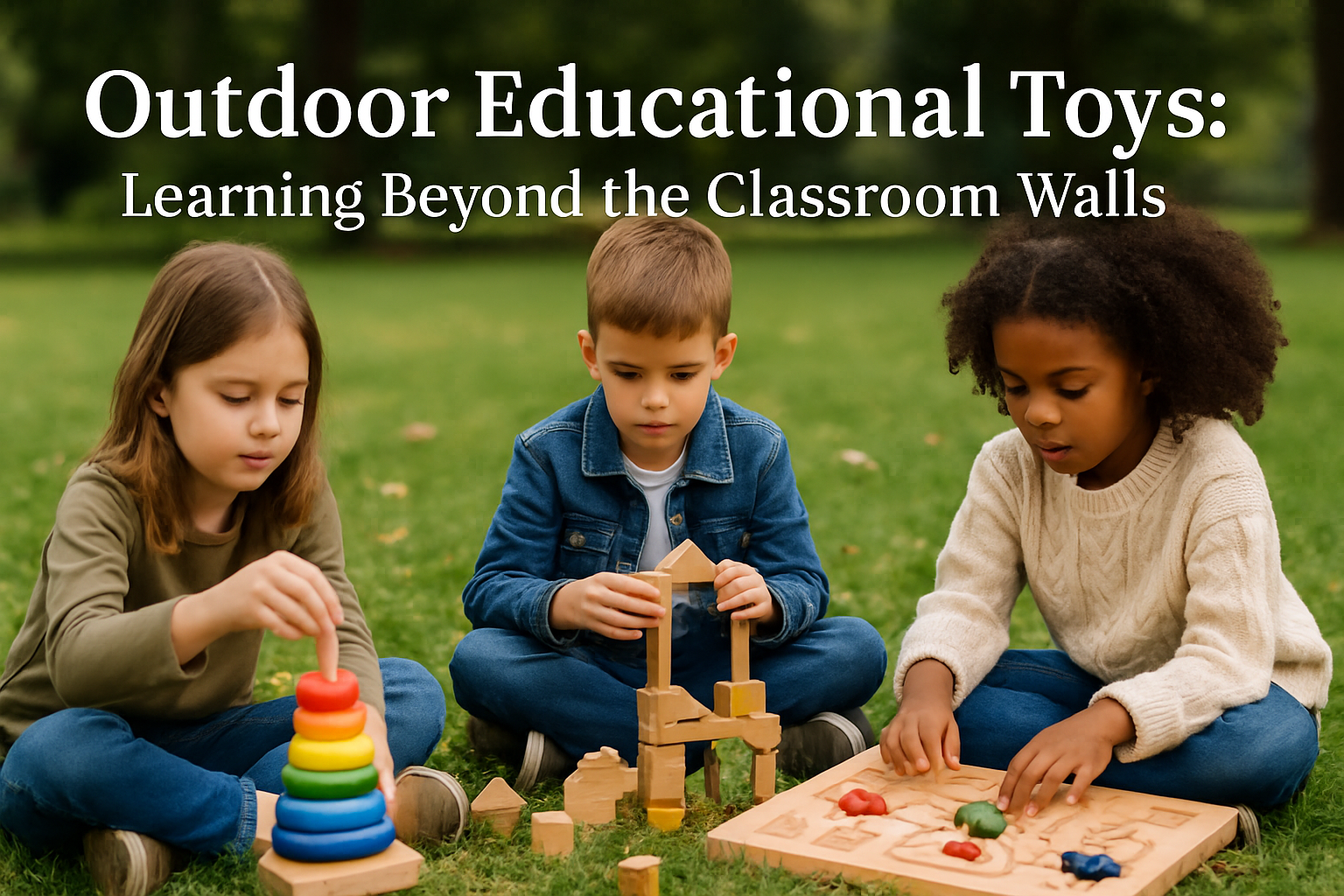The Most Popular Toy from Your Childhood: Did You Get to Play with It?
Understanding Outdoor Educational Toys Outdoor educational toys play a vital...
Add description, images, menus and links to your mega menu
A column with no settings can be used as a spacer
Link to your collections, sales and even external links
Add up to five columns
Add description, images, menus and links to your mega menu
A column with no settings can be used as a spacer
Link to your collections, sales and even external links
Add up to five columns

Outdoor educational toys play a vital role in children's development, encompassing a wide range of items designed to foster learning and growth outside the conventional classroom setting. These toys are not merely for play; they are tools crafted to engage children in meaningful activities that promote cognitive, physical, and social skills. By definition, outdoor educational toys are designed to encourage exploration, stimulate curiosity, and enable experiential learning. They provide opportunities for hands-on discovery, allowing children to interact with their environment in ways that traditional classroom toys may not facilitate.
The significance of outdoor educational toys lies in their ability to bridge the gap between educational concepts and real-world experiences. Unlike typical classroom settings, outdoor environments provide a dynamic backdrop that can inspire creativity and inventiveness. Whether climbing on a jungle gym, experimenting with a science kit, or engaging in cooperative games, children learn vital skills through these experiences. For instance, a simple activity like building a fort encourages teamwork and problem-solving while allowing for imaginative play. Such interactions not only promote physical health through active play but also reinforce emotional well-being by allowing children to express themselves freely.
In essence, outdoor educational toys offer a learning framework that goes beyond rote memorization and passive reception of information. They invite children to engage with the world around them, exploring natural concepts and fostering a lifelong love for learning. This interactive method of learning is vital as it cultivates critical thinking and adaptability, qualities essential for success in an ever-changing world. Embracing outdoor play as a medium for learning can transform children's understanding of their environment and lay a strong foundation for their continued educational journey.
The primary objective of this article is to highlight the benefits of outdoor educational toys, underlining their importance in the overall development of children. Outdoor educational toys are more than just physical objects; they are gateways to experiential learning that encourage children to think critically and act creatively. By examining the various advantages that these toys provide, the article aims to inform parents, educators, and caregivers about the profound impact outdoor play has on children's learning.
In exploring the roles outdoor educational toys play in fostering creativity, problem-solving, and hands-on discovery, this article delves into how these toys can support children's growth across multiple domains. Creative expression is encouraged through imaginative play, enabling children to visualize and create scenarios using their toys. Problem-solving skills are developed when children face challenges in play, whether it's overcoming physical obstacles or completing collaborative projects. Furthermore, hands-on discovery is a core component of outdoor toys, as they often incorporate elements that stimulate curiosity and investigative play.
Highlighting these benefits serves to further reinforce the notion that play is an essential part of the learning process. The article aims to provide insights that encourage the integration of outdoor educational toys into children's daily routines, ensuring that their time spent outdoors is as enriching as it is enjoyable. Through this exploration, the article seeks to inspire a shift in perspective on how education can extend beyond the confines of classroom walls, embracing the world as a larger classroom full of opportunities for learning and growth.
Engaging with outdoor educational toys brings myriad benefits that extend beyond mere entertainment. One of the primary advantages is fostering creativity in children. Outdoor toys are typically designed to promote imaginative play through open-ended activities. This type of play encourages kids to think outside the box and explore different scenarios, allowing them to develop their artistic sides. For instance, toys that allow children to create structures or engage in role-playing activities can lead to greater imaginative expression. By interacting with their surroundings, children learn to manipulate materials and ideas, leading to unique creative outcomes.
Moreover, when children engage in outdoor play, they frequently encounter opportunities for storytelling and imaginative scenarios. Toys that promote building, crafting, or nature exploration can spearhead imaginative adventures that fuel a child's creativity. These adventures may range from constructing elaborate worlds with building blocks to pretending to be explorers on a jungle expedition. The creativity sparked by these activities strengthens cognitive abilities and enhances the overall developmental experience.
Another significant benefit of outdoor educational toys is the enhancement of problem-solving skills. Engaging with toys that stimulate critical thinking and decision-making creates a natural environment for children to confront challenges. For example, climbing structures or obstacle courses may require children to think strategically about how to navigate and overcome barriers. Through these trials, they learn to assess possible solutions and make decisions based on their experiences, which is essential for their everyday lives.
Additionally, outdoor play often presents natural obstacles that compel children to troubleshoot. Whether it’s figuring out how to balance on a wobbly surface or strategizing the best route to take during play, these challenges support problem-solving development. Each encounter builds resilience and equips young minds with the tools needed to tackle future obstacles with confidence.
Finally, outdoor educational toys play a crucial role in promoting hands-on discovery. The importance of tactile experiences in learning cannot be overstated. When children engage with outdoor toys, they experience physical interactions with their environment that stimulate sensory learning. This engagement is vital as it allows children to experiment and explore freely, fostering a deeper understanding of the world around them.
Various outdoor toys, such as sand and water play sets or nature exploration kits, facilitate this type of hands-on discovery. Children can dig, mold, and discover different textures and elements in their outdoor environment. This experimentation encourages curiosity, inviting them to ask questions and seek answers through direct interaction, leading to a more profound learning experience. In essence, outdoor educational toys are not just tools for play; they are essential for developing various skills crucial for childhood growth.
Children are naturally curious, and their eagerness to learn is often showcased through play. This highlights the vital connection between fun and education, especially when it comes to outdoor toys. These toys serve not just as means of entertainment, but also as tools for learning. Balancing the elements of fun and education is essential for effective learning experiences. Outdoor toys, for instance, allow children to explore their surroundings while engaging in stimulating activities. When learning is infused with play, children are more likely to develop a lasting interest in their education.
Play is crucial for effective learning, acting as a medium that encourages exploration and experimentation. Outdoor play, which includes activities like climbing, jumping, and running, allows children to test their physical and cognitive abilities. This form of play nurtures essential life skills such as problem-solving and social interaction. When kids play with outdoor toys, they immerse themselves in practical learning scenarios. For example, building a sandcastle teaches concepts of architecture and balance, while collecting leaves can spark a fascination with nature and science. Thus, integrating play into learning fosters a rich educational environment where children can thrive.
In addition to curriculum-based knowledge, the joy derived from play enhances children's emotional and psychological development. Outdoor toys often encourage group play, promoting teamwork and collaboration. This interaction not only solidifies friendships but also instills a sense of community and belonging among children. When they engage with others, their motivation to learn increases, as they discover new perspectives and approaches to problem-solving. Ultimately, the balance of fun and education through outdoor play supports holistic development, allowing children to learn while enjoying themselves.
Outdoor toys play a pivotal role in capturing children’s interest through interactive and immersive experiences. The bright colors, engaging designs, and inviting textures of these toys attract young minds, igniting their imaginations. When children are naturally inclined to play, they display a heightened level of engagement, making learning a more enjoyable experience. Outdoor toys transform the learning process into a hands-on adventure, where children can dive deep into activities while exploring their environment. This sense of adventure cultivates a love for learning, setting the foundation for future educational pursuits.
Participation is another essential factor in maximizing learning outcomes. When children are active participants in their learning journey, they take ownership of their experiences. Outdoor toys facilitate this by allowing children to move around and explore. Whether climbing on a jungle gym or navigating an obstacle course, these activities require full engagement, which leads to improved retention of new concepts. As children physically interact with their environment, they connect lessons with real-world applications. This integration plays a vital role in reinforcing knowledge and ensuring that children not only learn but also understand the relevance of what they are being taught.
Moreover, active participation encourages adaptability and resilience. Outdoor play often presents challenges that require children to think critically and adjust their strategies on the spot. For example, when faced with a physical challenge, such as climbing or balancing, they learn to overcome obstacles, which is an invaluable lesson for their future academic and social endeavors. The experience gained from interactive play with outdoor toys builds confidence and fosters a positive attitude towards learning. When children see the direct impact of their actions, especially in a collaborative setting, it motivates them to embrace new ideas and dig deeper into their education. Through engagement and motivation, outdoor play becomes a significant driver for effective learning outcomes.
Outdoor educational toys play a significant role in child development. They provide children with hands-on experiences that stimulate their senses and promote active learning. Through play, children explore their surroundings, develop motor skills, and enhance their creativity. These toys are not just about fun; they serve as essential tools that help children engage with nature and encourage social interaction. This interaction fosters teamwork and communication skills as children participate in group activities, enhancing their overall learning experience.
The impact of outdoor educational toys extends beyond immediate enjoyment. Research shows that children who engage in outdoor play demonstrate increased cognitive abilities. Activities such as climbing, running, and building with natural materials allow children to apply problem-solving skills in real-world contexts. This experiential learning helps reinforce concepts such as physics and engineering, concepts that might seem abstract when taught indoors. By incorporating play-based learning in outdoor settings, children are better equipped to understand complex ideas and apply them in various scenarios.
In summary, outdoor educational toys contribute significantly to children's learning and development. They provide an engaging way for children to learn about their environment while developing essential skills. Families and educators should prioritize outdoor play to ensure children benefit from these experiences. Encouraging outdoor time not only nurtures children's physical health but also cultivates a love for nature and exploration. The lasting impact of outdoor play can shape children's attitudes and learning approaches as they grow, making these toys a vital element in modern childhood experiences.

Understanding Outdoor Educational Toys Outdoor educational toys play a vital...

Understanding Outdoor Educational Toys Outdoor educational toys play a vital...
Sign up for updates, sneak peeks and a coupon for 10% OFF your first order!